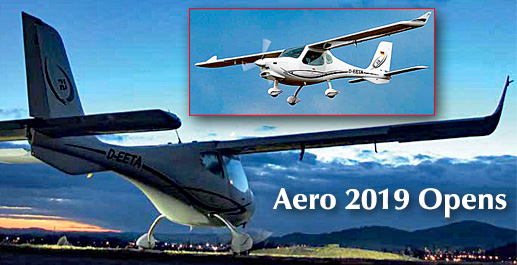
Many have asked about progress on FAA’s proposed rewrite of the Light-Sport Aircraft regulations. Following a lengthy teleconference at the end of June 2019, LAMA, the Light Aircraft Manufacturers Association, provided another update. The update to industry covered a lot of ground but here we’ve tried to make it a quicker read. Two key points: First, FAA is in the early stages of this rulemaking; at least minor changes are certain. FAA itself does not know all the specific details of the proposed rule at this time. Secondly, the steps reported here come from actual rule writers but their effort has support from top FAA leadership. Driven by a Congressional mandate we know this will go forward. LSA Is a Success Story For 15 years Light-Sport Aircraft and their producers have proven themselves, LAMA argued. FAA concurred; the agency has often referred to the safety record as “acceptable,” reasonably high praise from regulators.


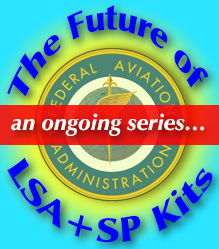 The update to industry covered a lot of ground but here we've tried to make it a quicker read.
Two key points: First, FAA is in the early stages of this rulemaking; at least minor changes are certain. FAA itself does not know all the specific details of the proposed rule at this time.
Secondly, the steps reported here come from actual rule writers but their effort has support from top FAA leadership. Driven by a Congressional mandate we know this will go forward.
The update to industry covered a lot of ground but here we've tried to make it a quicker read.
Two key points: First, FAA is in the early stages of this rulemaking; at least minor changes are certain. FAA itself does not know all the specific details of the proposed rule at this time.
Secondly, the steps reported here come from actual rule writers but their effort has support from top FAA leadership. Driven by a Congressional mandate we know this will go forward.
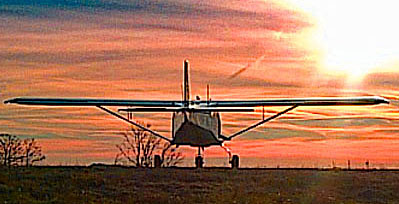 Regarding the much-anticipated max weight increase, FAA refers to a "Power Index." This term means a formula-based method to replace maximum takeoff weight in the definition of a LSA, involving wing area, horsepower, and takeoff weight.
FAA is also looking at up to four seats, “for personal use and for flight training.” Airspeeds — referring to maximum horizontal and never-to-exceed speeds (Vh and Vne) — may be higher than in the current rule, but will still be limited.
Neither will FAA be prescriptive about (that is, tightly defining) powerplants. The 2004 version of the LSA rule prohibited electric motors because rule writers wanted to discourage turbine power and therefore specified reciprocating engines, which knocked out electric. FAA will now consider both electric and hybrid.
Yet FAA was clear, “Movement of people for hire (such as the multicopter air taxis proposed by numerous companies) is not part of this.”
FAA is also reviewing what type of mechanics (LSR-M or A&P) can do what kind of work on specific systems of aircraft (examples: in-flight adjustable prop or electric propulsion systems).
Regarding the much-anticipated max weight increase, FAA refers to a "Power Index." This term means a formula-based method to replace maximum takeoff weight in the definition of a LSA, involving wing area, horsepower, and takeoff weight.
FAA is also looking at up to four seats, “for personal use and for flight training.” Airspeeds — referring to maximum horizontal and never-to-exceed speeds (Vh and Vne) — may be higher than in the current rule, but will still be limited.
Neither will FAA be prescriptive about (that is, tightly defining) powerplants. The 2004 version of the LSA rule prohibited electric motors because rule writers wanted to discourage turbine power and therefore specified reciprocating engines, which knocked out electric. FAA will now consider both electric and hybrid.
Yet FAA was clear, “Movement of people for hire (such as the multicopter air taxis proposed by numerous companies) is not part of this.”
FAA is also reviewing what type of mechanics (LSR-M or A&P) can do what kind of work on specific systems of aircraft (examples: in-flight adjustable prop or electric propulsion systems).
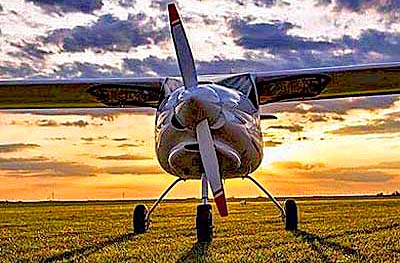 The FAA Reauthorization Act of 2018 includes a deadline of 2023 for implementing a key mandate that suggests the longest it should take. Once an NPRM is published, a comment period follows to hear from the public after which FAA needs time to address the concerns raised during that comment period. After closure of that comment period, the FAA has 16 months to publish the Final Rule.
Throughout the LAMA/FAA teleconference some ideas were repeated by FAA personnel…
The FAA Reauthorization Act of 2018 includes a deadline of 2023 for implementing a key mandate that suggests the longest it should take. Once an NPRM is published, a comment period follows to hear from the public after which FAA needs time to address the concerns raised during that comment period. After closure of that comment period, the FAA has 16 months to publish the Final Rule.
Throughout the LAMA/FAA teleconference some ideas were repeated by FAA personnel…
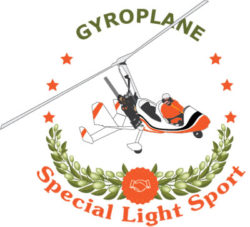 “All of these requests are on the table,” FAA acknowledged in the June teleconference. Of course, this does not mean all are certain to be included, but they represent a “huge opportunity [for industry and for pilots].”
“All of these requests are on the table,” FAA acknowledged in the June teleconference. Of course, this does not mean all are certain to be included, but they represent a “huge opportunity [for industry and for pilots].”
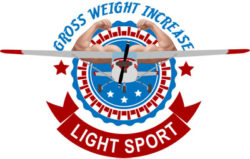 Under this more performance-based approach, LSA manufacturers would have more flexibility in making trade-offs among these parameters to meet a new power index limit. That new limit is intended to allow for up to a safe, robust, four-seat airplane.
“All this is seen [within the agency] as relieving on industry; enabling, not tightening the screws,” said FAA.
Under this more performance-based approach, LSA manufacturers would have more flexibility in making trade-offs among these parameters to meet a new power index limit. That new limit is intended to allow for up to a safe, robust, four-seat airplane.
“All this is seen [within the agency] as relieving on industry; enabling, not tightening the screws,” said FAA.
 “The Flight Standards people are considering [aerial work],” said FAA.
This important topic has been a priority for LAMA because it could become a vital activity to keep manufacturers healthy by expanding their capabilities and the markets they can serve. Pilots could also gain as this would provide more compensated flying jobs and business opportunities.
“The Flight Standards people are considering [aerial work],” said FAA.
This important topic has been a priority for LAMA because it could become a vital activity to keep manufacturers healthy by expanding their capabilities and the markets they can serve. Pilots could also gain as this would provide more compensated flying jobs and business opportunities.
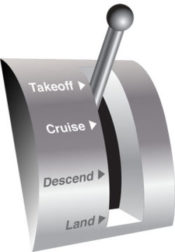 Single Lever Control
Single Lever Control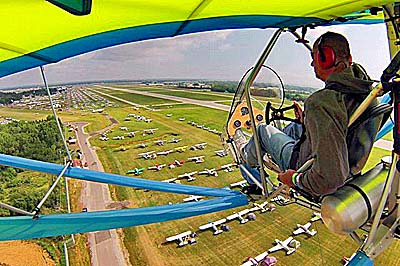

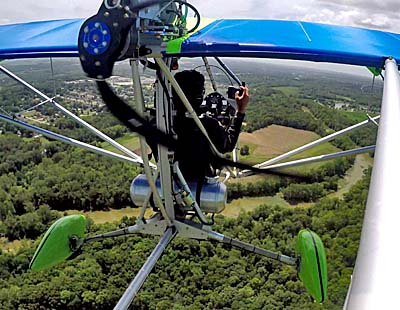 At Henry's age 13, the Scotts ordered an Aerolite. This followed many flights in a Cessna 150 with his father, where he learned all the basics of flight while someone was ready to assist when (and if) needed. However, at his youthful age and unable to obtain a Private Pilot certificate, Henry could not solo the C-150.
"We chose the Aerolite 103 because it looked like an airplane," explained William. "It was confidence inspiring. It had airplane features I was familiar with, such as flaps." Yet, he humorously added, "It's an anodized aluminum chair."
For readers that may not know, Part 103 is a very special regulation dating to 1982. The entire rule can be printed on the front and back of a single piece of paper making it aviation's most charming rule, in my opinion. No pilot certificate is required. No aircraft registration is required. No medical of any kind is needed. Plus, a Part 103 aircraft can be delivered fully ready to fly.
At Henry's age 13, the Scotts ordered an Aerolite. This followed many flights in a Cessna 150 with his father, where he learned all the basics of flight while someone was ready to assist when (and if) needed. However, at his youthful age and unable to obtain a Private Pilot certificate, Henry could not solo the C-150.
"We chose the Aerolite 103 because it looked like an airplane," explained William. "It was confidence inspiring. It had airplane features I was familiar with, such as flaps." Yet, he humorously added, "It's an anodized aluminum chair."
For readers that may not know, Part 103 is a very special regulation dating to 1982. The entire rule can be printed on the front and back of a single piece of paper making it aviation's most charming rule, in my opinion. No pilot certificate is required. No aircraft registration is required. No medical of any kind is needed. Plus, a Part 103 aircraft can be delivered fully ready to fly.
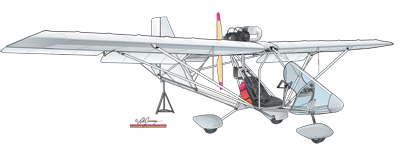
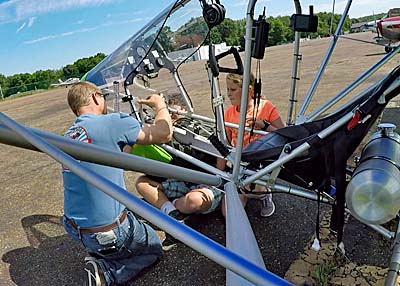
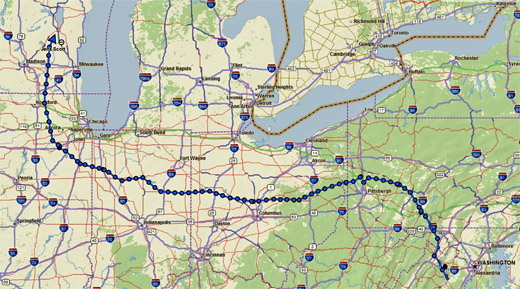
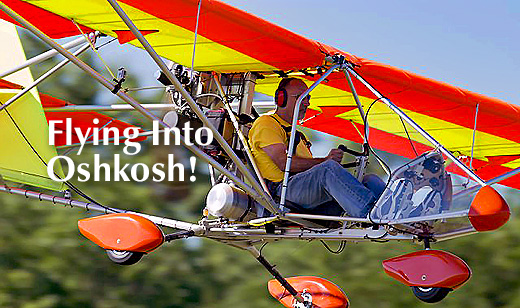
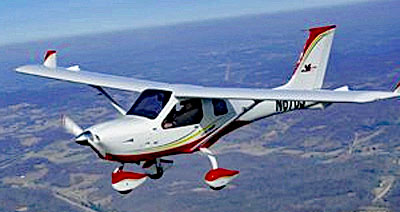
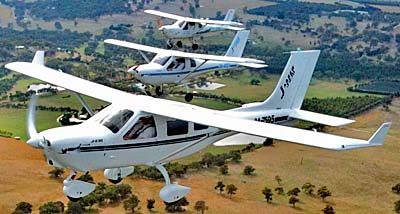 "Jabiru Aircraft will be offering an increased warranty at Oshkosh 2019, lasting the duration of the show," Scott explained, revealing great confidence in this roomiest of Light-Sport Aircraft. "The warranty offered will be five years or 1,000 hours, whichever occurs first, for the airframe and the engine."
Having followed light aircraft for many years, I have never heard a warranty for an aircraft that extends this long. Also, almost no other aircraft companies can offer a warranty on both airframe and engine, both manufactured by Jabiru in Australia.
"Jabiru Aircraft will be offering an increased warranty at Oshkosh 2019, lasting the duration of the show," Scott explained, revealing great confidence in this roomiest of Light-Sport Aircraft. "The warranty offered will be five years or 1,000 hours, whichever occurs first, for the airframe and the engine."
Having followed light aircraft for many years, I have never heard a warranty for an aircraft that extends this long. Also, almost no other aircraft companies can offer a warranty on both airframe and engine, both manufactured by Jabiru in Australia. 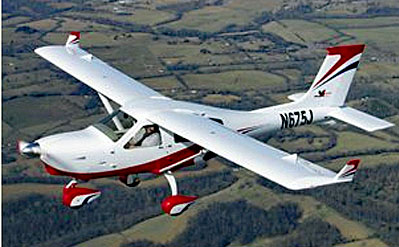
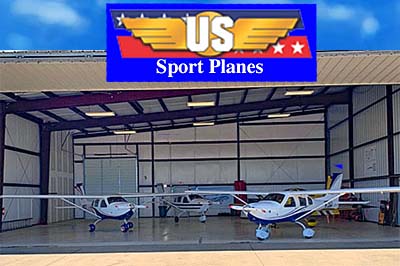 In case the J230-D price tag sounds beyond your budget, remember Jabiru has other choices.
"The 4-cylinder J170 is priced at $129,900," observed Scott. The smaller J170 pares down on some of the options but still comes set up for night VFR. It's equipped with the 7-inch Garmin G3X Touch Display with synthetic vision, flight director, ADS-B in and out offering weather and traffic on screen. The lower cost model does not have auto pilot, comes with a wood prop and no wheel pants plus the interior uses cloth rather than leather.
However, despite the lower price, "the Unbeatable Warranty applies to J170 as well," noted Scott.
At 2018's DeLand Showcase, Scott and I went up for a flight to make a Video Pilot Report. Look for that at Dave Loveman's
In case the J230-D price tag sounds beyond your budget, remember Jabiru has other choices.
"The 4-cylinder J170 is priced at $129,900," observed Scott. The smaller J170 pares down on some of the options but still comes set up for night VFR. It's equipped with the 7-inch Garmin G3X Touch Display with synthetic vision, flight director, ADS-B in and out offering weather and traffic on screen. The lower cost model does not have auto pilot, comes with a wood prop and no wheel pants plus the interior uses cloth rather than leather.
However, despite the lower price, "the Unbeatable Warranty applies to J170 as well," noted Scott.
At 2018's DeLand Showcase, Scott and I went up for a flight to make a Video Pilot Report. Look for that at Dave Loveman's 
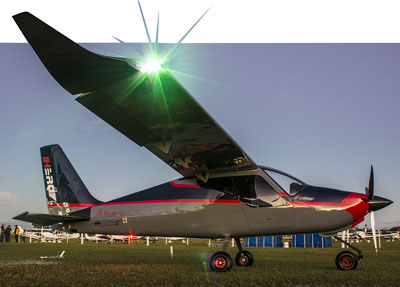 The cantilevered all-metal design has excellent ramp appeal, good specifications, and approval as a Special Light-Sport Aircraft is underway at this time, the developer said. He also added, is coming to the USA, to Florida, to be manufactured. The Brazilian invasion continues…
The cantilevered all-metal design has excellent ramp appeal, good specifications, and approval as a Special Light-Sport Aircraft is underway at this time, the developer said. He also added, is coming to the USA, to Florida, to be manufactured. The Brazilian invasion continues…
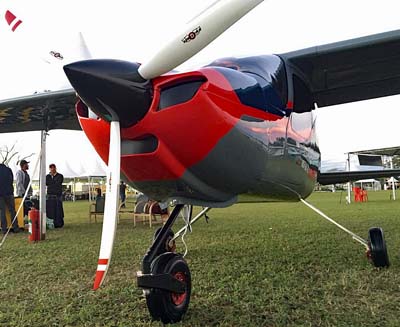 Evidence of Brazil's prowess in creating aircraft that fit the LSA category include the excellent
Evidence of Brazil's prowess in creating aircraft that fit the LSA category include the excellent 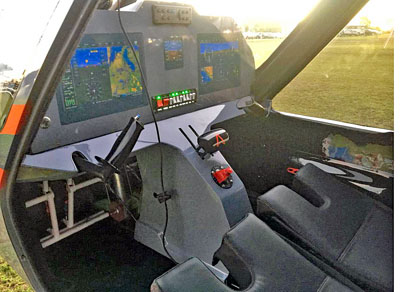 "All parts are manufactured with a high-speed CNC machine and precision tooling jigs," André clarified. The well-equipped deluxe Hero with "complete options, is priced at $180,000 (U.S. dollars).
For those who find that too much, he has another choice, called Pop Hero. "With standard options, the price is estimated $96,500, also in U.S. currency," André said. That is a large difference in price but André explained how the two models differ.
Pop Hero has similar construction using an all-aluminum 2024-T3 main spar and landing gear with 7075-T6511 alloy (same as the deluxe Hero). Pop Hero's wings keep the cantilever construction but all fasteners are pop rivets as on many Light-Sport Aircraft. That alone accounts for many hours in production savings.
Other differences to lower the price of Pop Hero include fairings made of fiberglass rather than carbon fiber; the Rotax 912 ULS carbureted engine; wheels and brake from Grove; an analog (round dial) instrument panel flanked with the very capable, if smaller format, Aera 660 GPS from
"All parts are manufactured with a high-speed CNC machine and precision tooling jigs," André clarified. The well-equipped deluxe Hero with "complete options, is priced at $180,000 (U.S. dollars).
For those who find that too much, he has another choice, called Pop Hero. "With standard options, the price is estimated $96,500, also in U.S. currency," André said. That is a large difference in price but André explained how the two models differ.
Pop Hero has similar construction using an all-aluminum 2024-T3 main spar and landing gear with 7075-T6511 alloy (same as the deluxe Hero). Pop Hero's wings keep the cantilever construction but all fasteners are pop rivets as on many Light-Sport Aircraft. That alone accounts for many hours in production savings.
Other differences to lower the price of Pop Hero include fairings made of fiberglass rather than carbon fiber; the Rotax 912 ULS carbureted engine; wheels and brake from Grove; an analog (round dial) instrument panel flanked with the very capable, if smaller format, Aera 660 GPS from 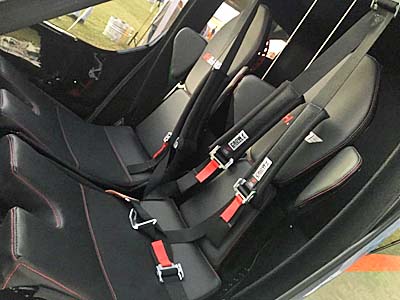 However, Pop Hero will still be delivered with Bose A20 headset, the Sensenich three blade prop, and sidestick. The lower-cost model is not pictured with this article "because we are working in its assembly, yet it is basically the same without winglets," André said.
The developer further signaled his U.S. plans. "My intention is to build this LSA at the DeLand, Florida airport (where the fall
However, Pop Hero will still be delivered with Bose A20 headset, the Sensenich three blade prop, and sidestick. The lower-cost model is not pictured with this article "because we are working in its assembly, yet it is basically the same without winglets," André said.
The developer further signaled his U.S. plans. "My intention is to build this LSA at the DeLand, Florida airport (where the fall 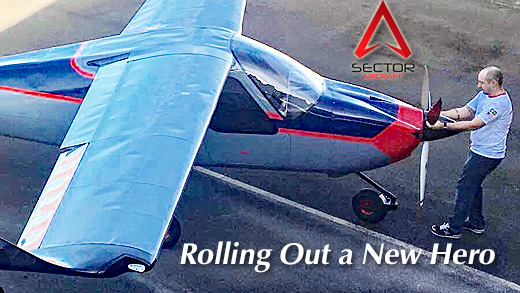
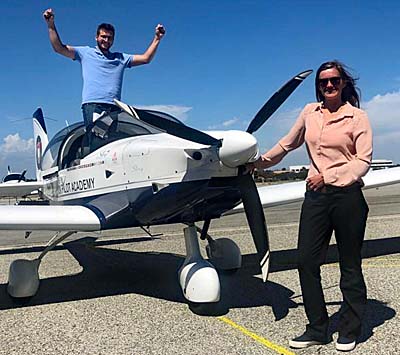

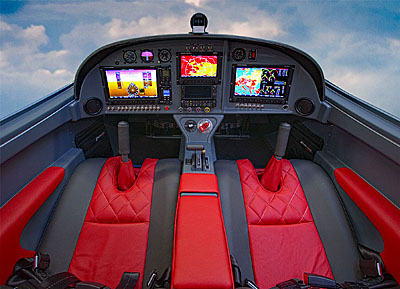
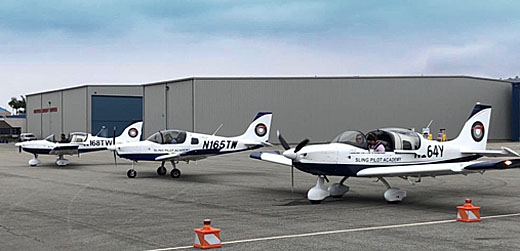 It's not just pilots either. Although it's a story worthy of another article, mechanics are predicted to have even higher job opportunities with pay scales increasing to entice trained workers. This is a great time to be a young person pursing aviation, better than I've seen in many decades of following aviation closely.
It's wonderful to see Sling Pilot Academy and Sebring Flight Academy rewriting the old rules of how a flight school should be operated. I'm exceptionally proud of both enterprises.
Current pilots can contact
It's not just pilots either. Although it's a story worthy of another article, mechanics are predicted to have even higher job opportunities with pay scales increasing to entice trained workers. This is a great time to be a young person pursing aviation, better than I've seen in many decades of following aviation closely.
It's wonderful to see Sling Pilot Academy and Sebring Flight Academy rewriting the old rules of how a flight school should be operated. I'm exceptionally proud of both enterprises.
Current pilots can contact 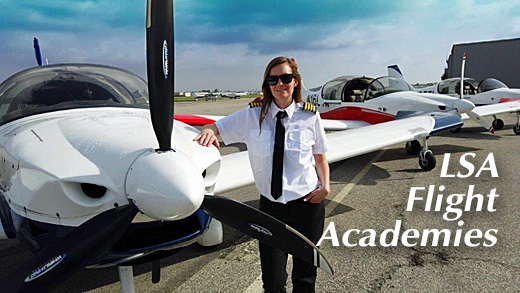
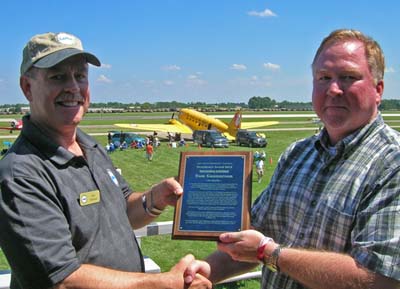
 In 2018, LAMA honored Adam Morrison, the steady hand at the tiller of the ASTM committee that writes and updates the industry consensus standards that allow LSA to fly in America and other countries without having to go through terribly expensive Part 23 (Type Certificate) level approval.
For his service to the light aircraft community, Adam Morrison was chosen after numerous nominations were received from hundreds of people.
For several recent years, Adam Morrison has led the F37 Committee for ASTM in what is a challenging and rather thankless task but one essential to the approval of new LSA. Like nearly all who work on this committee, Adam volunteers his time.
Adam successfully converted a childhood love for flying into a career focused on helping aircraft manufacturers prepare their designs for the market. Many of the leading companies have benefitted from his deep knowledge and expert guidance. His company,
In 2018, LAMA honored Adam Morrison, the steady hand at the tiller of the ASTM committee that writes and updates the industry consensus standards that allow LSA to fly in America and other countries without having to go through terribly expensive Part 23 (Type Certificate) level approval.
For his service to the light aircraft community, Adam Morrison was chosen after numerous nominations were received from hundreds of people.
For several recent years, Adam Morrison has led the F37 Committee for ASTM in what is a challenging and rather thankless task but one essential to the approval of new LSA. Like nearly all who work on this committee, Adam volunteers his time.
Adam successfully converted a childhood love for flying into a career focused on helping aircraft manufacturers prepare their designs for the market. Many of the leading companies have benefitted from his deep knowledge and expert guidance. His company, 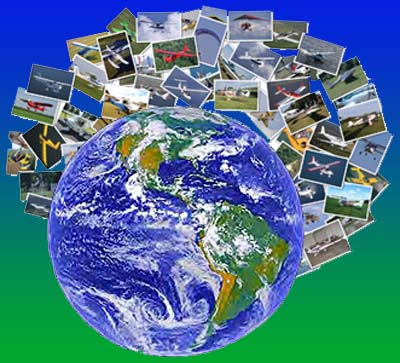 For this 28th year of this award, aviation professionals have been invited to submit a name for consideration. From all the nominations received, the one with the most votes wins. Very simple rules guide the vote.
As LAMA founder, Larry Burke, told pros, "Select any individual you wish from the aviation community … someone you think has made significant contributions to the light aviation field."
During or after AirVenture 2019, LAMA will announce the newest recipient of the organization's highest award.
For this 28th year of this award, aviation professionals have been invited to submit a name for consideration. From all the nominations received, the one with the most votes wins. Very simple rules guide the vote.
As LAMA founder, Larry Burke, told pros, "Select any individual you wish from the aviation community … someone you think has made significant contributions to the light aviation field."
During or after AirVenture 2019, LAMA will announce the newest recipient of the organization's highest award.
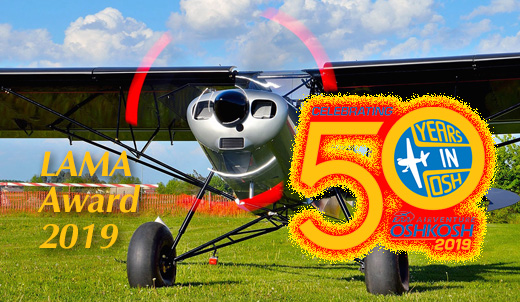
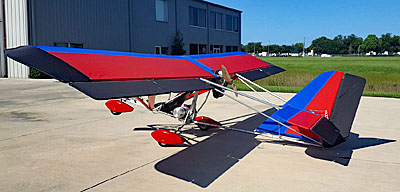 In an age where many Light-Sport Aircraft run $150,000, to well… possibly much more, "affordability" becomes something of a tortured word. What might seem affordable to a pilot that can buy a nearly one million dollar Cirrus SR22 is vastly different from what is affordable to most readers of this website. So, how affordable can Aerolite be to warrant my claiming "super affordability?"
Rob Tuttle, following Aerolite on Facebook, posed a similar question, "How much minus delivery?"
In an age where many Light-Sport Aircraft run $150,000, to well… possibly much more, "affordability" becomes something of a tortured word. What might seem affordable to a pilot that can buy a nearly one million dollar Cirrus SR22 is vastly different from what is affordable to most readers of this website. So, how affordable can Aerolite be to warrant my claiming "super affordability?"
Rob Tuttle, following Aerolite on Facebook, posed a similar question, "How much minus delivery?"
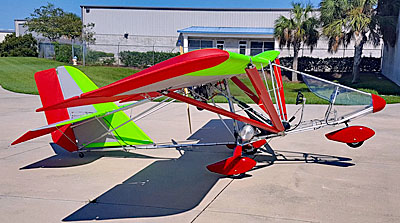 Consider this perspective. Automobile companies, building tens or hundreds of thousands of a single model, have an average U.S. selling price of more than $35,000 in 2019. Yet here is an airplane, being built at a tiny fraction of the quantity of any automobile, selling for as little as half the price of the average new car. I find that amazing — and it appears a sufficient number to keep U-Fly-It active and profitable, so much so that the DeLand, Florida company can't keep up.
A couple years ago, Dennis revived the idea of a kit Aerolite 103. Prices around $18,000 ready-to-fly may still be more than some people want to pay for an aircraft that is like a boat, motorcycle, or ATV — it's a machine you have fun with and it needs to fit within your family budget.
Today a kit Aerolite can save even more and the build time won't be long.
Consider this perspective. Automobile companies, building tens or hundreds of thousands of a single model, have an average U.S. selling price of more than $35,000 in 2019. Yet here is an airplane, being built at a tiny fraction of the quantity of any automobile, selling for as little as half the price of the average new car. I find that amazing — and it appears a sufficient number to keep U-Fly-It active and profitable, so much so that the DeLand, Florida company can't keep up.
A couple years ago, Dennis revived the idea of a kit Aerolite 103. Prices around $18,000 ready-to-fly may still be more than some people want to pay for an aircraft that is like a boat, motorcycle, or ATV — it's a machine you have fun with and it needs to fit within your family budget.
Today a kit Aerolite can save even more and the build time won't be long.
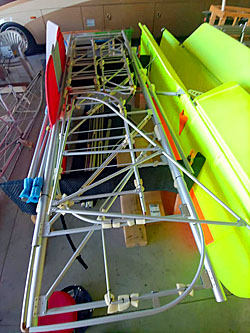
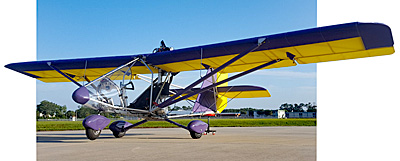 Is Hirth's 28-horsepower F33 enough power for bigger pilots, say someone weighing 250 pounds? Dennis answered.
"The
Is Hirth's 28-horsepower F33 enough power for bigger pilots, say someone weighing 250 pounds? Dennis answered.
"The 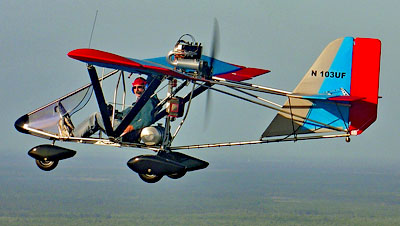 Are Aerolite prices enticing for what many consider to be a dandy little airplane? Perhaps the following answer sums it up. When asked by a customer if U-Fly-It has any plans for a two seat model, Dennis' responded, "We are building so many single seaters that we just don't have time to make a two-seater. We literally can not build them fast enough."
I don 't know many other companies in all of light aviation that can say that.
Check out our new video of Aerolite 103 in flight.
https://youtu.be/z7L4NFluh7g
Are Aerolite prices enticing for what many consider to be a dandy little airplane? Perhaps the following answer sums it up. When asked by a customer if U-Fly-It has any plans for a two seat model, Dennis' responded, "We are building so many single seaters that we just don't have time to make a two-seater. We literally can not build them fast enough."
I don 't know many other companies in all of light aviation that can say that.
Check out our new video of Aerolite 103 in flight.
https://youtu.be/z7L4NFluh7g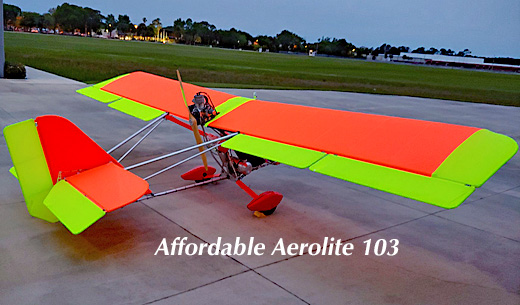
 Then came a pause in the juggernaut that is
Then came a pause in the juggernaut that is 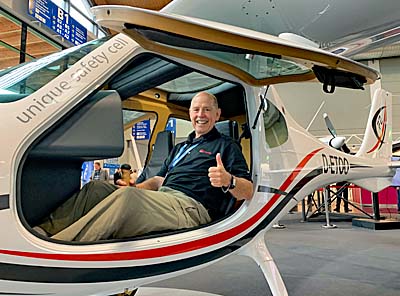 F2's cabin is 3.1 inches wider — now 51 inches wide, among the broadest in the category — and two inches taller than the CT series’ cabins. Door dimensions have also been increased, making for easier entry and exit. The entry door is set 2.3 inches lower than those in the CT series and pilots who are less flexible will appreciate these changes. Four cabin windows and a sunroof in the rear give the cockpit an open feeling and improve overall visibility, boasts Flight Design.
F2 is available with either a 100-horsepower
F2's cabin is 3.1 inches wider — now 51 inches wide, among the broadest in the category — and two inches taller than the CT series’ cabins. Door dimensions have also been increased, making for easier entry and exit. The entry door is set 2.3 inches lower than those in the CT series and pilots who are less flexible will appreciate these changes. Four cabin windows and a sunroof in the rear give the cockpit an open feeling and improve overall visibility, boasts Flight Design.
F2 is available with either a 100-horsepower 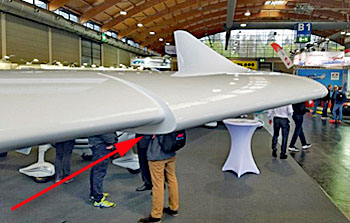
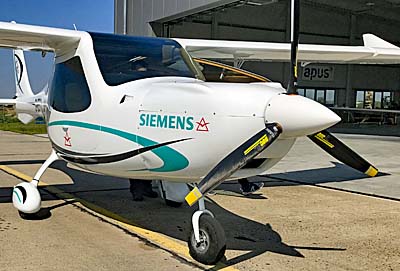 On its first successful first flight, Flight Design said, "Energy consumption for take-off and cruise was within the expected range, and the temperatures in the system were more positive than expected."
Flight Design created F2e with partners
On its first successful first flight, Flight Design said, "Energy consumption for take-off and cruise was within the expected range, and the temperatures in the system were more positive than expected."
Flight Design created F2e with partners 
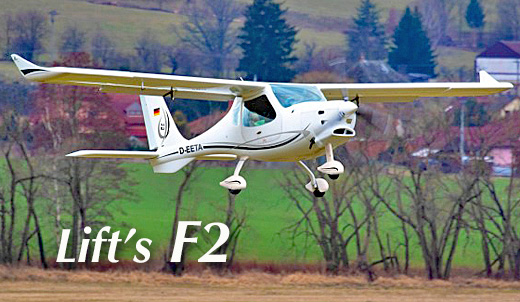
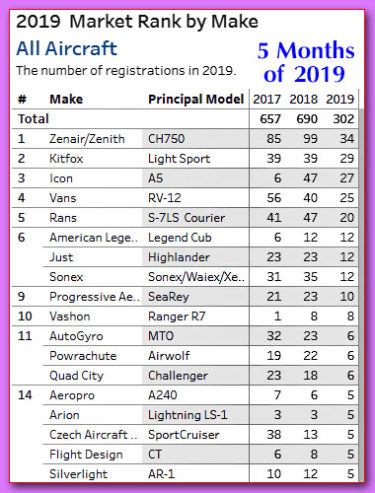 Our first quarterly report in many years should have come about April 1st. It did not. That date came as
Our first quarterly report in many years should have come about April 1st. It did not. That date came as 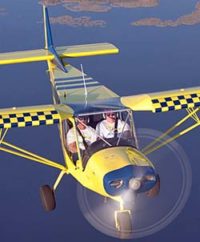 Digging deeper, the chart shows that longtime market leader
Digging deeper, the chart shows that longtime market leader 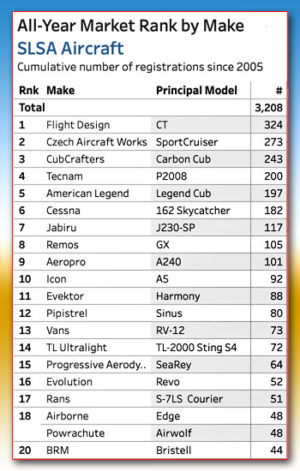 Strong SP kit suppliers include
Strong SP kit suppliers include 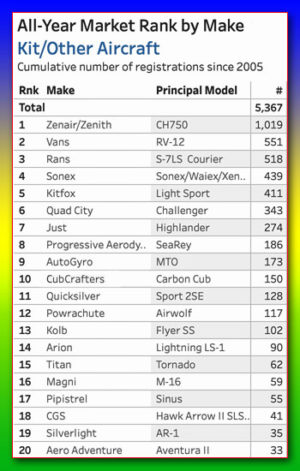 Yet the real surprise comes when you look at our final chart of this article. Kits appear ascendant since 2013, especially when compared to Special LSA that seems to have found a stable registration rate of around 200 aircraft per year. However, when you combine SLSA with Experimental LSA, you can see that all LSA types number closer to 300 units per year, compared to all SP kits at just shy of 400. Specialty registrations like Experimental Exhibition are steady but at a far smaller unit count.
Yet the real surprise comes when you look at our final chart of this article. Kits appear ascendant since 2013, especially when compared to Special LSA that seems to have found a stable registration rate of around 200 aircraft per year. However, when you combine SLSA with Experimental LSA, you can see that all LSA types number closer to 300 units per year, compared to all SP kits at just shy of 400. Specialty registrations like Experimental Exhibition are steady but at a far smaller unit count.
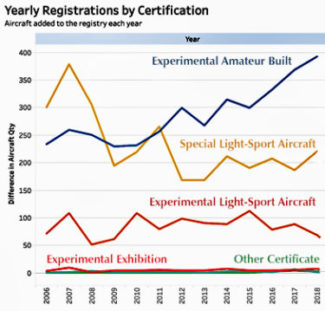 Any ELSA must be shipped from the factory as a bolt-for-bolt copy of the SLSA model, as required under the regulation. No producer can sell an ELSA without first getting approved for a SLSA, so to my mind, combining SLSA and ELSA makes for a fairer comparison to Sport Pilot kit aircraft.
If you love these numbers, please visit
Any ELSA must be shipped from the factory as a bolt-for-bolt copy of the SLSA model, as required under the regulation. No producer can sell an ELSA without first getting approved for a SLSA, so to my mind, combining SLSA and ELSA makes for a fairer comparison to Sport Pilot kit aircraft.
If you love these numbers, please visit 
 If that's an accurate assessment, then let the drooling begin over this beautifully contoured flying machine that can race 135 to 185 miles an hour for a fairly modest investment. I'm writing about Lightning from
If that's an accurate assessment, then let the drooling begin over this beautifully contoured flying machine that can race 135 to 185 miles an hour for a fairly modest investment. I'm writing about Lightning from 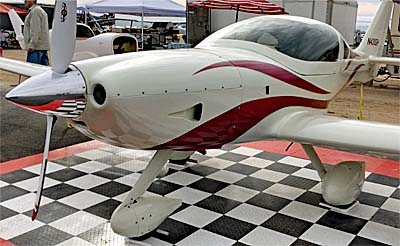 "Lightning LS-1 is designed and built around Jabiru’s powerful 3300 aircraft engine," noted Arion. "With a displacement of over 200 cubic inches and a direct drive crank, this little beauty has over 120 horsepower on tap for performance rarely matched in a Light-Sport Aircraft." Lightning has no trouble hitting the LSA speed limit of 120 knots (138 mph).
"[We] spent more than three years making the kit Lightning as efficient and fast as we could, so slowing down to 120 knots was a complete reversal of thinking that had its benefits," said principal and designer, Nick Otterback. "By changing the airfoil slightly and adding three feet of wing span, LS-1 stalls below 44 knots clean, giving our aircraft an impressive 52 knot approach speed." Solo climb is in excess of 1,200 fpm and owners can expect 1,000 fpm at 1,320 pounds. At cruise speeds of 120 knots range fuel burns runs 5.5 gallons an hour. "These are real performance numbers a pilot can rely on; not on a perfect day at sea level or flying around solo, but all loaded up," stated Nick.
"Lightning LS-1 is designed and built around Jabiru’s powerful 3300 aircraft engine," noted Arion. "With a displacement of over 200 cubic inches and a direct drive crank, this little beauty has over 120 horsepower on tap for performance rarely matched in a Light-Sport Aircraft." Lightning has no trouble hitting the LSA speed limit of 120 knots (138 mph).
"[We] spent more than three years making the kit Lightning as efficient and fast as we could, so slowing down to 120 knots was a complete reversal of thinking that had its benefits," said principal and designer, Nick Otterback. "By changing the airfoil slightly and adding three feet of wing span, LS-1 stalls below 44 knots clean, giving our aircraft an impressive 52 knot approach speed." Solo climb is in excess of 1,200 fpm and owners can expect 1,000 fpm at 1,320 pounds. At cruise speeds of 120 knots range fuel burns runs 5.5 gallons an hour. "These are real performance numbers a pilot can rely on; not on a perfect day at sea level or flying around solo, but all loaded up," stated Nick.
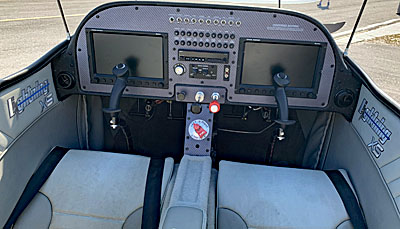 Most companies list useful load, but Arion said the more meaningful payload can be up to 470 pounds. That will allow two big Americans plus some luggage assuming weight and balance confirms. "Now standard equipped with 40 gallons of fuel, you can go over 800 nautical miles with VFR reserves," Nick added.
Lightning is offered only in tricycle-gear configuration — as most pilots prefer — but a taildragger version has been created by a builder.
Most companies list useful load, but Arion said the more meaningful payload can be up to 470 pounds. That will allow two big Americans plus some luggage assuming weight and balance confirms. "Now standard equipped with 40 gallons of fuel, you can go over 800 nautical miles with VFR reserves," Nick added.
Lightning is offered only in tricycle-gear configuration — as most pilots prefer — but a taildragger version has been created by a builder. 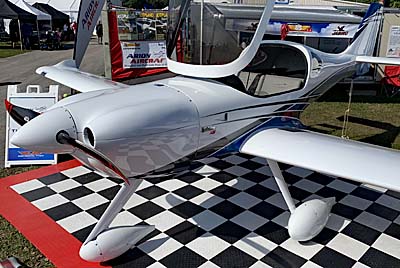 Taller landing gear permits bigger props on this new kit to allow the speedier model to hit speeds of 160 knots (184 mph). Firewall aft XS is much the same as the classic Lightning including its 42-inch wide cabin.
Arion also offers several propeller choices for the engines above. "For fixed pitch we like Sensenich wood or composite ground adjustable props," said Arion. "We have tested in-flight adjustable props as well. For the Titan or Lycoming types, Whirlwind aviation makes the RV200 series light weight CS prop. For Jabiru or UL Power we have tested the Airmaster series." Installation of an in-flight adjustable prop can increase performance but, of course, builders must plan for the extra weight on the nose during the build process. Pricing and other questions are answered on Arion's
Taller landing gear permits bigger props on this new kit to allow the speedier model to hit speeds of 160 knots (184 mph). Firewall aft XS is much the same as the classic Lightning including its 42-inch wide cabin.
Arion also offers several propeller choices for the engines above. "For fixed pitch we like Sensenich wood or composite ground adjustable props," said Arion. "We have tested in-flight adjustable props as well. For the Titan or Lycoming types, Whirlwind aviation makes the RV200 series light weight CS prop. For Jabiru or UL Power we have tested the Airmaster series." Installation of an in-flight adjustable prop can increase performance but, of course, builders must plan for the extra weight on the nose during the build process. Pricing and other questions are answered on Arion's 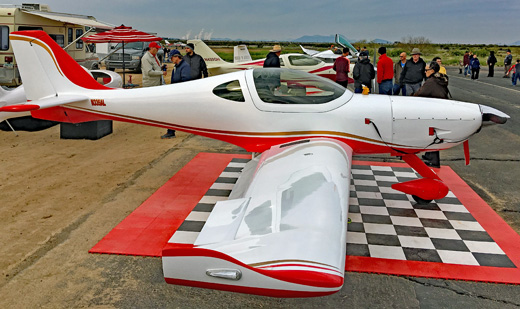
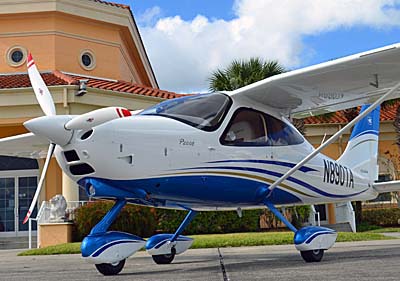
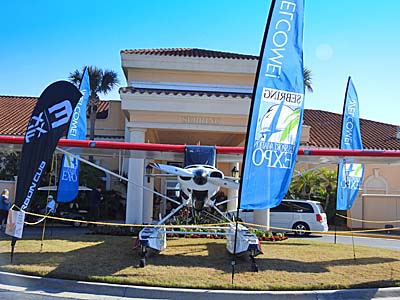
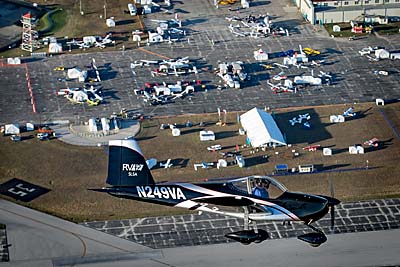
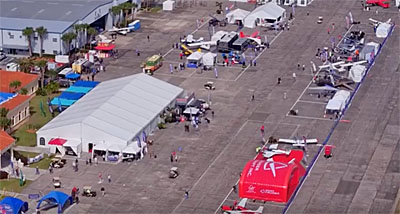
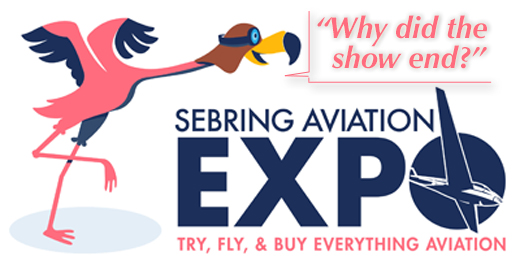
 The show started the same year LSA arrived on the scene — barely a month after FAA announced the new airplane and pilot certificate category — as the event was initially held in October before shifting to January to avoid hurricane season disruptions that affected the first year.
Sebring was hardly on the aviation map as the show began. A notable early success was attracting Phil Lockwood and his multiple enterprises. Those who know Phil are aware he is a particularly careful and deliberate planner so his selection of KSEF was significant and perhaps presaged the long and successful run of Sebring Expo.
Over the years, airport executive director Mike Willingham and those he retained to operate the event tried various tactics including a night airshow, adding drone racing and exhibits to the mix, plus relocating the center of activity, finally ending up right in front of the new beautiful airport terminal Mike initiated during his equally long run as the man in charge.
The show started the same year LSA arrived on the scene — barely a month after FAA announced the new airplane and pilot certificate category — as the event was initially held in October before shifting to January to avoid hurricane season disruptions that affected the first year.
Sebring was hardly on the aviation map as the show began. A notable early success was attracting Phil Lockwood and his multiple enterprises. Those who know Phil are aware he is a particularly careful and deliberate planner so his selection of KSEF was significant and perhaps presaged the long and successful run of Sebring Expo.
Over the years, airport executive director Mike Willingham and those he retained to operate the event tried various tactics including a night airshow, adding drone racing and exhibits to the mix, plus relocating the center of activity, finally ending up right in front of the new beautiful airport terminal Mike initiated during his equally long run as the man in charge.
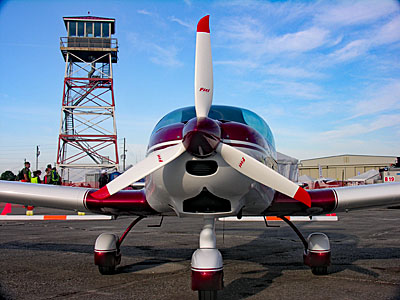 The LSA community embraced Sebring enthusiastically as the new segment roared into the aviation space. Dozens of new aircraft producers and the many customers who loved them enjoyed having an event where LSA and Sport Pilot kit aircraft plus ultralights were the leading attraction.
A primary reason for the event's success was the sector-specific nature of the show. Pilots could comb the field for the best choice for them and they could take multiple demonstration flights to zero in on the right aircraft for them. The smaller nature of the event assured that prospective buyers could get plenty of face time with suppliers of their favorite LSA or kits and they could have long enough conversations with them to be sure before making a substantial investment in a new aircraft.
"
The LSA community embraced Sebring enthusiastically as the new segment roared into the aviation space. Dozens of new aircraft producers and the many customers who loved them enjoyed having an event where LSA and Sport Pilot kit aircraft plus ultralights were the leading attraction.
A primary reason for the event's success was the sector-specific nature of the show. Pilots could comb the field for the best choice for them and they could take multiple demonstration flights to zero in on the right aircraft for them. The smaller nature of the event assured that prospective buyers could get plenty of face time with suppliers of their favorite LSA or kits and they could have long enough conversations with them to be sure before making a substantial investment in a new aircraft.
"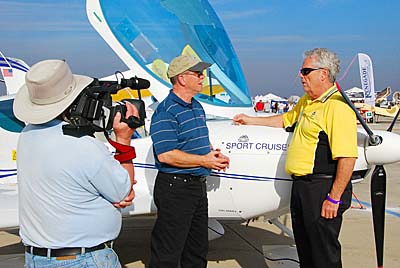 What will Sebring Regional Airport do to promote itself and aviation in the future? "[We] will continue to focus resources and energy toward the development of new programs in emerging aviation areas including manned,
What will Sebring Regional Airport do to promote itself and aviation in the future? "[We] will continue to focus resources and energy toward the development of new programs in emerging aviation areas including manned, 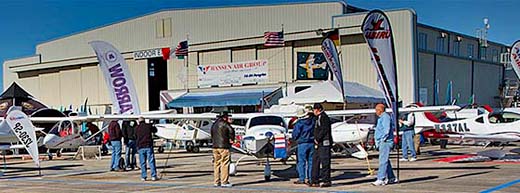 LSA and Sport Pilot kit-oriented enterprises based at Sebring include Lockwood Supply and
LSA and Sport Pilot kit-oriented enterprises based at Sebring include Lockwood Supply and 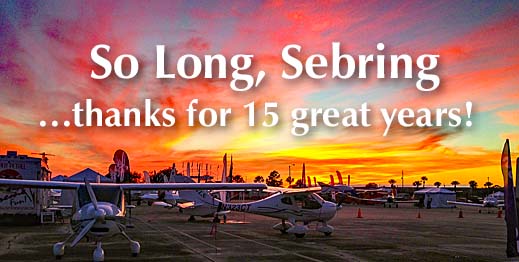 "The news came as a shock," Plane & Pilot continued, "with the company suddenly announcing on Wednesday, May 29 that 2019 will be its last year. Three races remain for this year’s series, with events in Russia, Hungary and Japan. In all, the series has included more than 90 races.”
"The news came as a shock," Plane & Pilot continued, "with the company suddenly announcing on Wednesday, May 29 that 2019 will be its last year. Three races remain for this year’s series, with events in Russia, Hungary and Japan. In all, the series has included more than 90 races.”
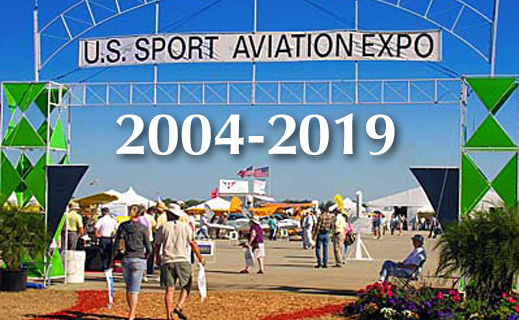
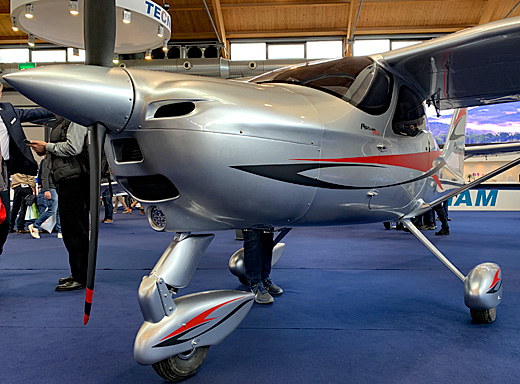
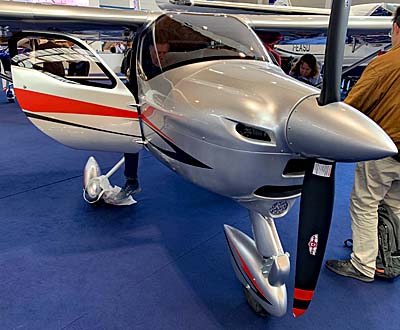 They elaborated that they chose both materials —making this a true composite — for the optimization of aerodynamic qualities, flight characteristic, and reliability. "This addition enabled [us] to make construction decisions based on optimum design and structural integrity rather than purely the cost of production."
P92 Echo MkII's interior has also been completely redone. "Doors are lined with automotive-type door seals, seats that give full support with excellent leg room, side map pockets as well as pockets in the back of the seats combine to make the MkII a very comfortable aircraft."
They elaborated that they chose both materials —making this a true composite — for the optimization of aerodynamic qualities, flight characteristic, and reliability. "This addition enabled [us] to make construction decisions based on optimum design and structural integrity rather than purely the cost of production."
P92 Echo MkII's interior has also been completely redone. "Doors are lined with automotive-type door seals, seats that give full support with excellent leg room, side map pockets as well as pockets in the back of the seats combine to make the MkII a very comfortable aircraft."
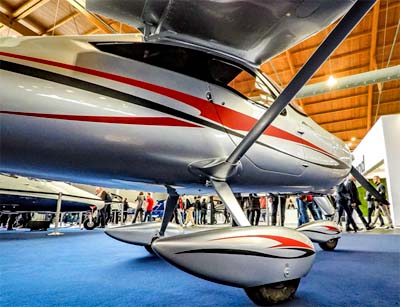 Tecnam has long boasted "uncompromising build quality" and P92 MkII has been built to meet requirements for Europe's CS/VLA standards for aircraft certified to this category. Tecnam offers models meeting the European ultralight category (different than the U.S. interpretation of that term), LSA ASTM standards, and Part 23 fully certified aircraft. They make models using twin Rotax power and an 11-seat regional aircraft (seen briefly in the video alongside the P92 MkII).
Beside "excellent visibility, roomy space, quiet and ergonomic," P92 uses an all-movable stabilator-type horizontal tail that is traditional on Tecnam aircraft. They say this "allows excellent controllability and excellent 'hands off' longitudinal stability." My own experience backs up this claim. Every Tecnam I've ever flown (most models) have superlative handling.
Tecnam has long boasted "uncompromising build quality" and P92 MkII has been built to meet requirements for Europe's CS/VLA standards for aircraft certified to this category. Tecnam offers models meeting the European ultralight category (different than the U.S. interpretation of that term), LSA ASTM standards, and Part 23 fully certified aircraft. They make models using twin Rotax power and an 11-seat regional aircraft (seen briefly in the video alongside the P92 MkII).
Beside "excellent visibility, roomy space, quiet and ergonomic," P92 uses an all-movable stabilator-type horizontal tail that is traditional on Tecnam aircraft. They say this "allows excellent controllability and excellent 'hands off' longitudinal stability." My own experience backs up this claim. Every Tecnam I've ever flown (most models) have superlative handling.
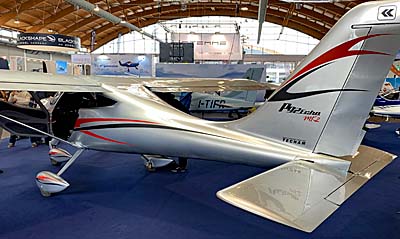 Inside P92 MkII, "the cabin offers newly designed seats and seat rails which are easily operated and adjustable fore and aft via a single handle with a reinforced area between the rails to make cabin access even easier." The company continued, "A roomy baggage compartment with internal access accommodates voluminous items. A comfortable armrest and USB charger round out the luxurious interior."
A generously sized instrument panel provides plenty of room for digital screen avionics although a base model is available with simple analog instruments. The model you see in the images and video represent the "Glass Package" featuring avionics from
Inside P92 MkII, "the cabin offers newly designed seats and seat rails which are easily operated and adjustable fore and aft via a single handle with a reinforced area between the rails to make cabin access even easier." The company continued, "A roomy baggage compartment with internal access accommodates voluminous items. A comfortable armrest and USB charger round out the luxurious interior."
A generously sized instrument panel provides plenty of room for digital screen avionics although a base model is available with simple analog instruments. The model you see in the images and video represent the "Glass Package" featuring avionics from 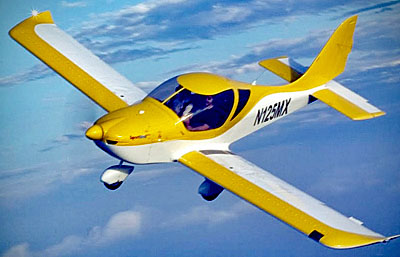 Indeed, outside of the LSA world, many pilots I've spoken to believe these aircraft are too lightly built to hold up in flight training, one of the most demanding of all flight activities. "Yes, an experienced pilot may love a LSA," they may concede, "but these aircraft cannot hold up to regular flight instruction duty." Enthusiasts may be biased but what would an actual flight school operator say?
To get it straight from the horse's mouth, I inquired of
Indeed, outside of the LSA world, many pilots I've spoken to believe these aircraft are too lightly built to hold up in flight training, one of the most demanding of all flight activities. "Yes, an experienced pilot may love a LSA," they may concede, "but these aircraft cannot hold up to regular flight instruction duty." Enthusiasts may be biased but what would an actual flight school operator say?
To get it straight from the horse's mouth, I inquired of 
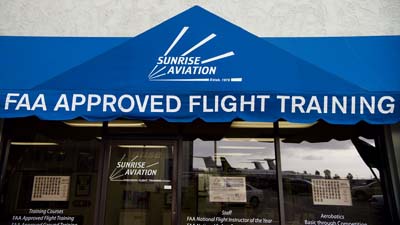
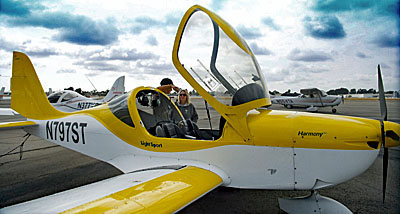
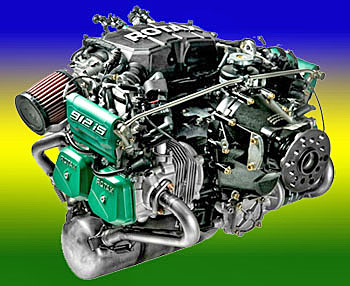 Sunrise mechanic Matt Wilderman is an A&P with Inspection Authorization. He relates experience since 2009.
"I've never worked with an airplane that demanded so little maintenance. It's mostly been tires and brakes. We've had no major airframe issues and very minor engine issues." He enthusiastically added, "If you keep on top of them, they've been fantastically reliable, more so than any other airplane I've worked on."
How does Matt feel about Rotax? "They've also been fantastic. I've never worked with a better aircraft engine." To clarify, Matt added, "We change the spark plugs, the oil, and the filters every 50 hours. Even running avgas we've had no problems with leading that some people have reported. In 2,000 hours we replaced one small spring on the sprague clutch; that's it."
"We've had no lubrication issues, no ignition issues. I had questions at first, but despite hard use by students, the engines have held up exceptionally well. Most squawks that I've received have been indicators; it always seems to be the sensor but today even those problems appear to be resolved."
"The airframes are so light that you don't see a lot of wear," Matt continued, and in so saying he turns the "light" problem upside down to become a positive. "They just haven't been breaking. I have nothing but praise for the whole LSA program."
Sunrise mechanic Matt Wilderman is an A&P with Inspection Authorization. He relates experience since 2009.
"I've never worked with an airplane that demanded so little maintenance. It's mostly been tires and brakes. We've had no major airframe issues and very minor engine issues." He enthusiastically added, "If you keep on top of them, they've been fantastically reliable, more so than any other airplane I've worked on."
How does Matt feel about Rotax? "They've also been fantastic. I've never worked with a better aircraft engine." To clarify, Matt added, "We change the spark plugs, the oil, and the filters every 50 hours. Even running avgas we've had no problems with leading that some people have reported. In 2,000 hours we replaced one small spring on the sprague clutch; that's it."
"We've had no lubrication issues, no ignition issues. I had questions at first, but despite hard use by students, the engines have held up exceptionally well. Most squawks that I've received have been indicators; it always seems to be the sensor but today even those problems appear to be resolved."
"The airframes are so light that you don't see a lot of wear," Matt continued, and in so saying he turns the "light" problem upside down to become a positive. "They just haven't been breaking. I have nothing but praise for the whole LSA program."
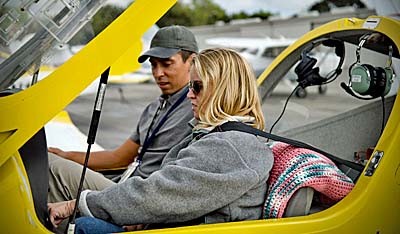
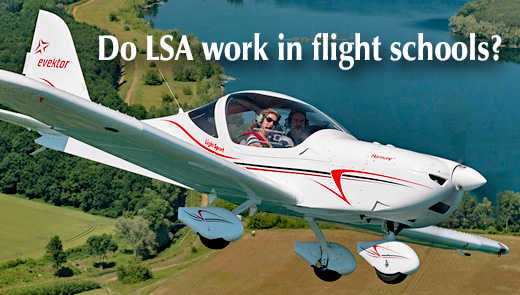
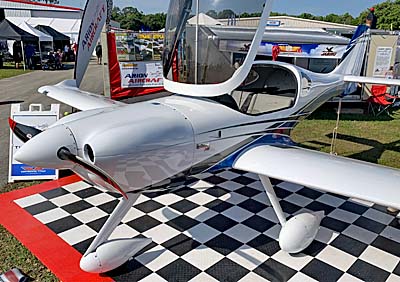
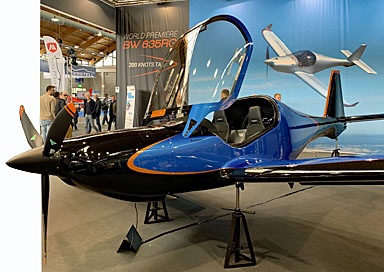
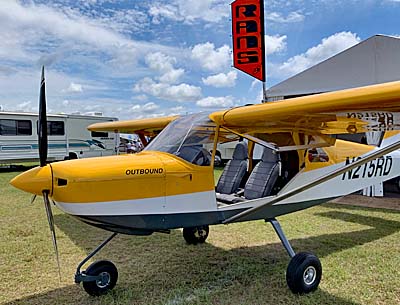
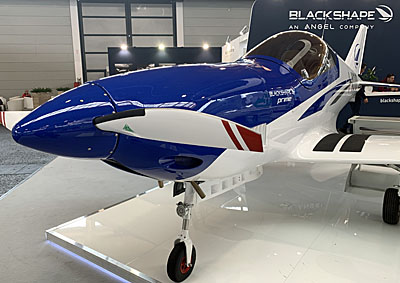
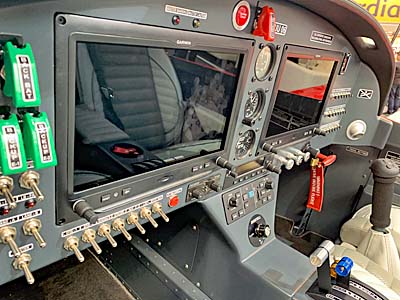
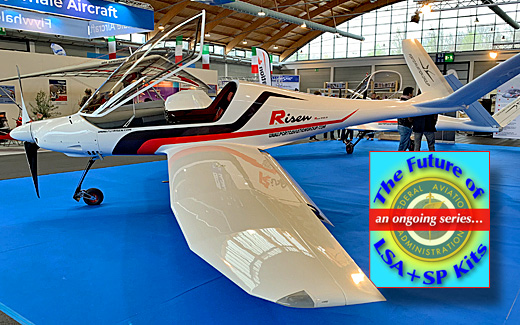
 After the rush of daily reporting from
After the rush of daily reporting from 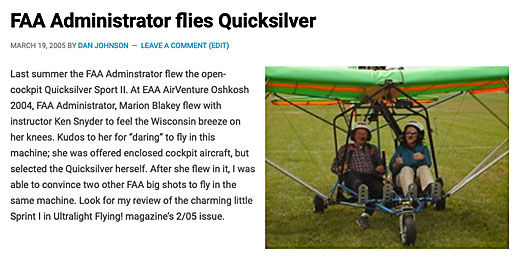
 We could not publish this website without the talented folks who design, manufacture, and distribute their fine aircraft or flying gear. Please thank those whose advertisements appear on either side of this news because their support is essential. We are deeply grateful for many individual
We could not publish this website without the talented folks who design, manufacture, and distribute their fine aircraft or flying gear. Please thank those whose advertisements appear on either side of this news because their support is essential. We are deeply grateful for many individual 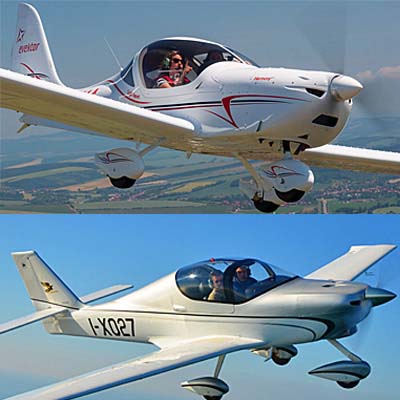 ByDanJohnson.com does not cover certified aircraft, commercial aviation, helicopters, airships, or space travel …although I find all those categories interesting. The good news for those segments is you have many great outlets, online or in print, that cover those activities in great detail. I'm happy we have them and I wish them the best. I know most of the journalists in this space and am humbled to be one of them.
I have focused this website like a laser beam on three categories: Light-Sport Aircraft, Sport Pilot kits, and Ultralights — and we will maintain our tight attention on those aircraft and them alone. We hope (and believe) you like it that way.
ByDanJohnson.com does not cover certified aircraft, commercial aviation, helicopters, airships, or space travel …although I find all those categories interesting. The good news for those segments is you have many great outlets, online or in print, that cover those activities in great detail. I'm happy we have them and I wish them the best. I know most of the journalists in this space and am humbled to be one of them.
I have focused this website like a laser beam on three categories: Light-Sport Aircraft, Sport Pilot kits, and Ultralights — and we will maintain our tight attention on those aircraft and them alone. We hope (and believe) you like it that way.

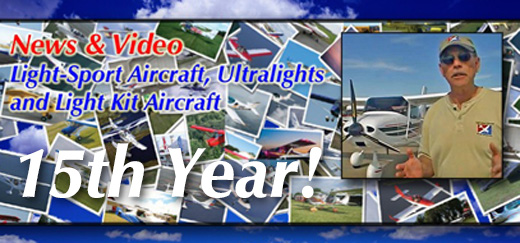
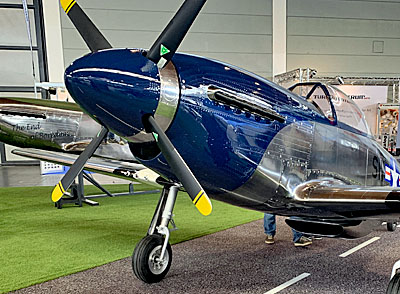 ScaleWings SW51
ScaleWings SW51 Blackwing 600RG
Blackwing 600RG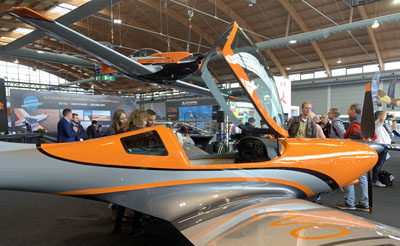 JMB Aircraft Update
JMB Aircraft Update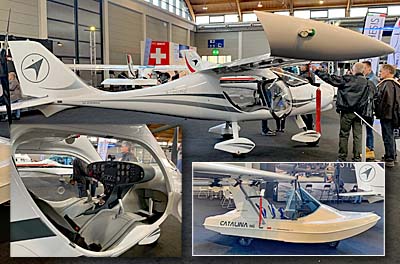 Fly Synthesis Synchro & Catalina
Fly Synthesis Synchro & Catalina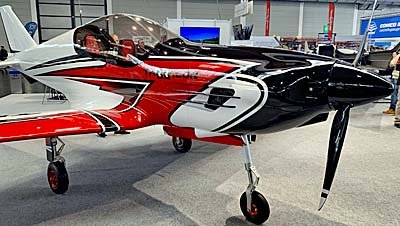 The stories from
The stories from 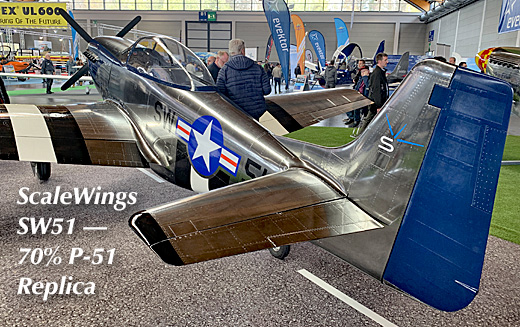
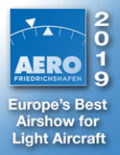 More from Aero as Day 3 closes. Because of the number on display — and because several readers asked — this post will focus on electric propulsion in two distinct forms. Whatever you think about electric as a means of lifting aircraft aloft, escaping its approach appears impossible. Experimentation is happening in all quarters. The following review is far from exhaustive; many other examples could be found at
More from Aero as Day 3 closes. Because of the number on display — and because several readers asked — this post will focus on electric propulsion in two distinct forms. Whatever you think about electric as a means of lifting aircraft aloft, escaping its approach appears impossible. Experimentation is happening in all quarters. The following review is far from exhaustive; many other examples could be found at 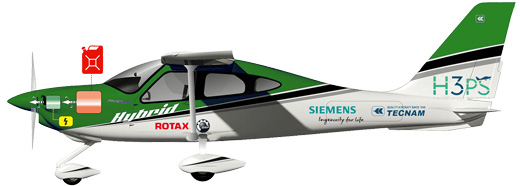 Beside taking the lead in this investigation, funded by the "European Union Horizon 2020 research and innovation programme,"
Beside taking the lead in this investigation, funded by the "European Union Horizon 2020 research and innovation programme," 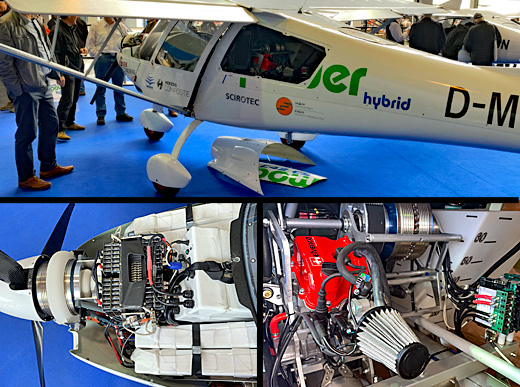 The big difference in this development compared to the H3PS project is that Toni flew the Comco Ikarus C-42 CS Elektro from his base near the factory to Aero. This hybrid is operating now. Technical information about the system was sparse on Toni's website, however, a German-language video (below) shows the aircraft operated essentially the same as its fossil fuel-powered counterparts.
When I spoke with Toni at the show. I recalled this man has has long experience with light trikes and hang glider propulsion systems based on electric power. He has gained valuable experience with these efforts and the results appear on his Comco C42C.
As an example of his state of development, the installation featured a cooling system but also a source of passenger comfort. A collar around the electric motor (white "doughnut" surrounding the motor) removes heat from the motor and channels it to the cabin. In the aft compartment, we saw a tidy installation of electric motor, generator, and a petrol fuel tank holding about 15 gallons.
The big difference in this development compared to the H3PS project is that Toni flew the Comco Ikarus C-42 CS Elektro from his base near the factory to Aero. This hybrid is operating now. Technical information about the system was sparse on Toni's website, however, a German-language video (below) shows the aircraft operated essentially the same as its fossil fuel-powered counterparts.
When I spoke with Toni at the show. I recalled this man has has long experience with light trikes and hang glider propulsion systems based on electric power. He has gained valuable experience with these efforts and the results appear on his Comco C42C.
As an example of his state of development, the installation featured a cooling system but also a source of passenger comfort. A collar around the electric motor (white "doughnut" surrounding the motor) removes heat from the motor and channels it to the cabin. In the aft compartment, we saw a tidy installation of electric motor, generator, and a petrol fuel tank holding about 15 gallons.
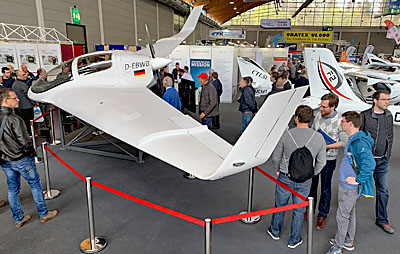 You may have already jumped to the point about those wings being exactly where the
You may have already jumped to the point about those wings being exactly where the 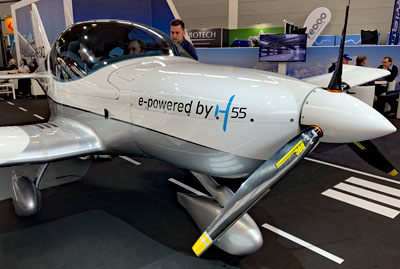 The company is now taking their smooth aircraft and powering it with an electric motor. They call the project B23 H55 Energic. The motor can deliver 90 kW (122 horsepower) for takeoff at 900 fpm and 65 kW (88 horsepower) for continuous cruise power at 125 mph. Onboard batteries can deliver one hour of endurance with a 20-minute reserve. Fully recharging will take only about 30 minutes. BRM estimates the cost of operation at $7/hour, less than the cost of one gallon of fuel at current European prices for avgas.
To repeat, this is far from a complete list of electric projects. Indeed, all of Hall A-7 at Aero Friedrichshafen was electric, with the giant Siemens company hosting a particularly large display. With multi-billion-euro companies like this involved — along with other giants of aviation and technology — it is clear that electric propulsion is on its way. How soon? What range is possible? What is the full cost …and saving? These and more questions remain to be answered but the technology is getting closer with every Aero. Look for more reporting on this at next
The company is now taking their smooth aircraft and powering it with an electric motor. They call the project B23 H55 Energic. The motor can deliver 90 kW (122 horsepower) for takeoff at 900 fpm and 65 kW (88 horsepower) for continuous cruise power at 125 mph. Onboard batteries can deliver one hour of endurance with a 20-minute reserve. Fully recharging will take only about 30 minutes. BRM estimates the cost of operation at $7/hour, less than the cost of one gallon of fuel at current European prices for avgas.
To repeat, this is far from a complete list of electric projects. Indeed, all of Hall A-7 at Aero Friedrichshafen was electric, with the giant Siemens company hosting a particularly large display. With multi-billion-euro companies like this involved — along with other giants of aviation and technology — it is clear that electric propulsion is on its way. How soon? What range is possible? What is the full cost …and saving? These and more questions remain to be answered but the technology is getting closer with every Aero. Look for more reporting on this at next 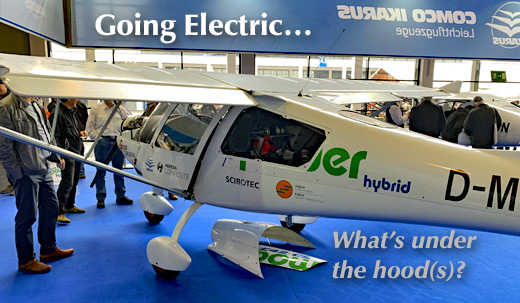
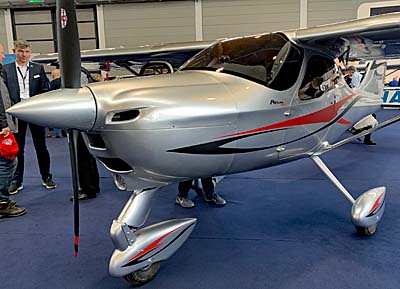 Tecnam P92 Mk II
Tecnam P92 Mk II Magnaghi SkyArrow
Magnaghi SkyArrow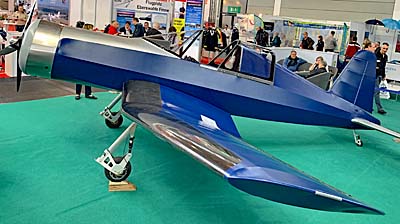 JH Aircraft Corsair
JH Aircraft Corsair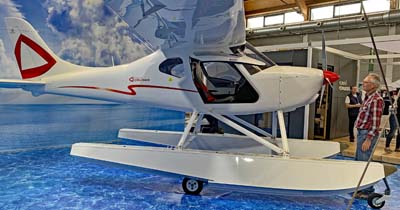 CSA Delta Cruiser
CSA Delta Cruiser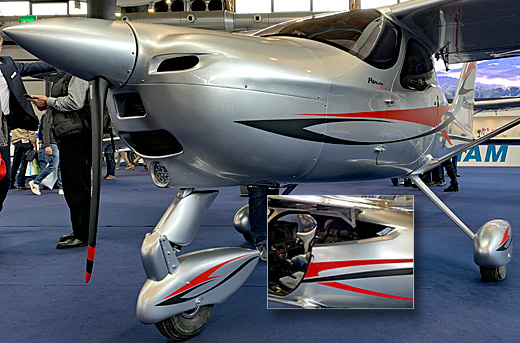
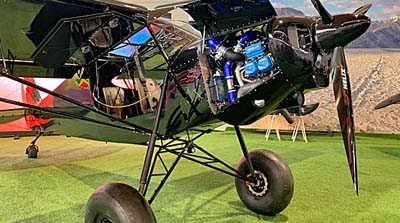 Zlin Ultra with Rotax 915iS
Zlin Ultra with Rotax 915iS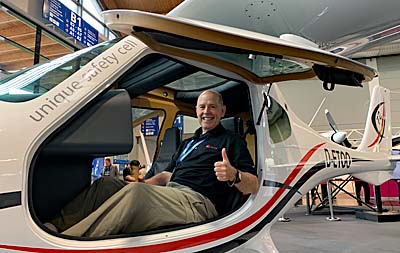
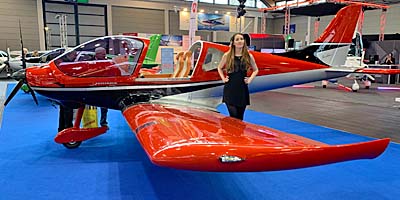 Belmont Aero DW200
Belmont Aero DW200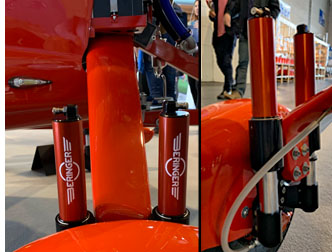 Beringer Everywhere
Beringer Everywhere